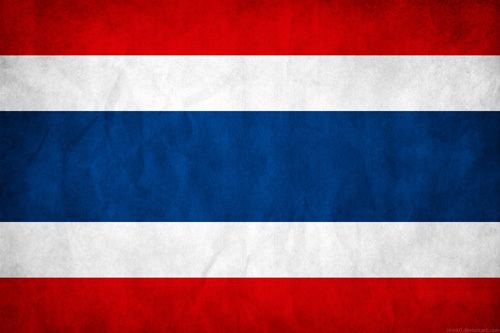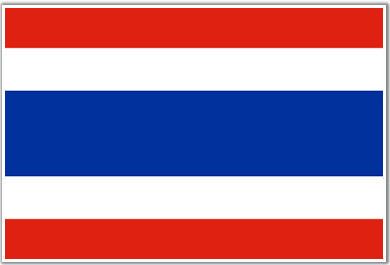Adopted on 28 September 1917 Designed by Vajiravudh | Proportion 2:3 | |
 | ||
Use National flag, Civil ensign, State ensign | ||
The flag of the Kingdom of Thailand (Thai: ธงไตรรงค์, Thong Trairong, meaning "tricolour flag”) shows five horizontal stripes in the colours red, white, blue, white and red, with the central blue stripe being twice as wide as each of the other four. The design was adopted on 28 September 1917, according to the royal decree issued by Rama VI that year.
Contents

The colours are said to stand for nation-religion-king, an unofficial motto of Thailand, red for the land and people, white for religions and blue for the monarchy, the last having been the auspicious colour of Rama VI. As the king declared war on Germany that July, some note the flag now bore the same colours as those of Britain, France, Russia and the United States.

Design

The Flag Act of BE 2522 (1979 CE) stipulates the design of national flag as "a rectangle 6 portions in width and 9 portions in length, vertically divided into five full-length horizontal stripes: at the middle, a blue stripe 2 portions wide; flanking the blue stripe, two white stripes 1 portion wide each; and outwardly flanking the white stripes, two red stripes 1 portion wide each. The flag shall also to be known as the Trairanga."

The colours of the flag were standardised in a convention held by the National Identity Office on 7 May 2010, and are pending formal adoption as a Thai Industrial Standard. The adopted specifications are Munsell value 5R4/12 for the red, and 7.5PB2/4 for the blue.
History
The first flag used for Siam was probably a plain red one, first used under King Narai (1656–1688). Naval flags later used different symbols on the red ground—a white chakra (the weapon of the Hindu god Vishnu, which is also used as the symbol of the House of Chakri), or a white elephant inside the chakra.
Officially the first flag was created in 1855 by King Mongkut (Rama IV), showing a white elephant (a royal symbol) on red ground, as the plain coloured flag was not distinct enough for international relations.
In 1916 the flag was changed to show a white elephant in royal regalia. In 1917, the current design, but with the middle colour being the same red as the outer stripe, was defined as the civil ensign. The story goes that during a flood King Vajiravudh (Rama VI) saw the flag hanging upside-down, and to prevent this from happening again created a new flag which was symmetrical. Later in 1917, the middle colour was changed to dark blue, which was similar in tone to indigo, which at the time was regarded as the auspicious colour for Saturday, the day King Vajiravudh was born. According to other sources, the blue colour was also chosen to show solidarity with the Allies of World War I, which also had the colours blue-red-white in their flags.
Maritime flags
The naval ensign of the Royal Thai Navy is the national flag with a red circle in the middle that reaches as far as the red stripes at the top and bottom. In the circle stands a white elephant, in full caparison, facing the hoist The kingdom's naval jack is the national flag defaced with the emblem of the Royal Thai Navy in the middle. The regimental colours of the RTN is as same as this flag; both ensigns were adopted in 1917.
